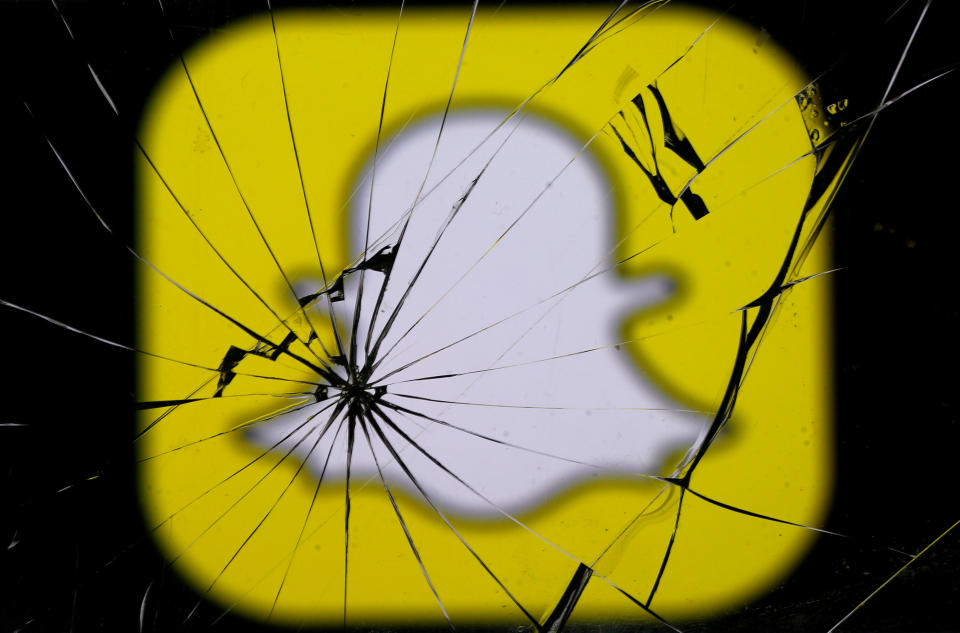Snap will keep getting copied and crushed
Snap’s second-ever earnings report as a public company was expected to be bad, and it ended up being even worse. The numbers reflect the major long-term problems that Snap (SNAP) faces.
The chat company missed analysts’ expectations on revenue ($181.7 million vs. $186.2 million expected), earnings (it lost 16 cents per share, which was more than the 14 cents expected) and, most troublingly for its future, daily active users (it clocked 173 million vs. 175.2 million expected). Snap shares went off a cliff on the news, falling 16%, almost down to half of its $17 IPO price.
It is difficult to make a bull case for this company right now.
It is difficult to argue that Snap CEO Evan Spiegel made the right decision when he reportedly turned down two separate sale offers, one from Facebook (FB) for $3 billion in 2013 and one from Google (GOOG, GOOGL) for $30 billion last year.
Getting “copied and crushed”
In an interview with Yahoo Finance in June, Ted Livingston, CEO of the messaging app Kik, commented that young tech startups, even those with some fresh new innovation to offer, are currently more at risk of getting killed off by Big Tech (think Facebook, Google, Apple [AAPL] and Amazon [AMZN]) than ever before. These giants, with massive built-in user bases, can easily ape the popular products of smaller players and scale them faster. Livingston called it getting “copied and crushed.”
It’s a perfect phrase for what has already happened to Snapchat, and what can easily continue to happen.
Snapchat got copied and crushed when Facebook-owned Instagram added Instagram Stories in August 2016, an obvious ripoff of Snapchat Stories, which lets users share photos or videos that last 24 hours on their profiles. By April of this year, less than eight months later, Instagram Stories surpassed Snapchat with 250 million daily active users. Facebook soon added Stories to Messenger, WhatsApp, and at last the Facebook app, too.
Stories isn’t the only way Facebook has copied Snapchat. Facebook added a new camera to Messenger that looks just like the Snap camera. Facebook also added mid-story video ads to Instagram that show up the same way Snapchat ads appear to users.
There’s little Snap can do about all this. And of course the phenomenon is hardly new: tech companies copy each other’s products all the time, often with great success.

Some analysts think Facebook isn’t even the problem, but Snap itself.
“I think 100 percent of the problems that we’re seeing at Snapchat are self-inflicted,” James Cakmak of Monness, Crespi, Hardt and Co., told Bloomberg TV. “They’re not doubling down on the core areas of expertise that we thought that they could capitalize on, like the content side of the picture, and they’re not really educating the existing users, as well as new potential users, on the new product iterations.”
You could take a small dose of financial optimism from two metrics in Snap’s earnings: revenue, while it fell short of expectations, was up more than 150% from a year ago; and, as Jackdaw Research analyst Jan Dawson points out, Snap’s ARPU (annual revenue per user) is growing nicely outside the US.
There are a few specific products that Snap believers might point to as bright spots, but any of these could get copied by a larger giant, and many already are.
Discover, the Snapchat feature with original content created specially for Snapchat by publishers, has grown, but Google is reportedly working on something similar.
NFL content has done especially well for Snapchat (NFL has its own Discover channel), but since Amazon got the package this year to stream 10 Thursday Night Football games (for $50 million), people are going to be talking about Amazon when they talk about NFL video content on non-cable platforms, not Snap.
Snap recently expanded its ad products, offering new self-serve tools for advertisers that utilize Snap’s lenses and geofilters (which are viewed over 1 billion times per day). But Facebook and Google loom large: the two are contributing 90% of the growth in the digital ad sales market right now.
In June, Snap acquired social mapping app Zenly for a reported $250 to $350 million in order to roll out a Snap Map feature that shows you were your friends are sending snaps from. But Instagram had an earlier Photo Maps feature that it discontinued last year; it could easily bring it back if it decides Snap is having enough success with its own photo mapping.
Snap Spectacles now sell on Amazon (when it went public, Snap famously called itself a “camera company”) and Snap sold more than 40,000 of them this quarter, but that was down from more than 60,000 units last quarter. And Apple is rumored to be working on its own AR (augmented reality) glasses.
Snap still selling tens of thousands of Spectacles per q. Not a huge business by any stretch, but is selling (now on Amazon) pic.twitter.com/1a1kCphuaa
— Jan Dawson (@jandawson) August 10, 2017
And finally, speaking of AR, Snap CEO Evan Spiegel, on the Q2 earnings call, specifically touted Snapchat’s dancing hot dog, calling it “most likely the world’s first augmented-reality superstar.” But in June, Apple rolled out ARKit, a platform for AR developers.
In other words, everything Snap does, the big dogs can do too—and will, quickly, if they decide it’s worth it.
—
Daniel Roberts covers tech and media at Yahoo Finance.
Read more:
The problem with Snap calling itself a ‘camera company’
Why chat app Kik is jumping into the digital currency game
Facebook’s new sports feature is bad news for Twitter and Snapchat
